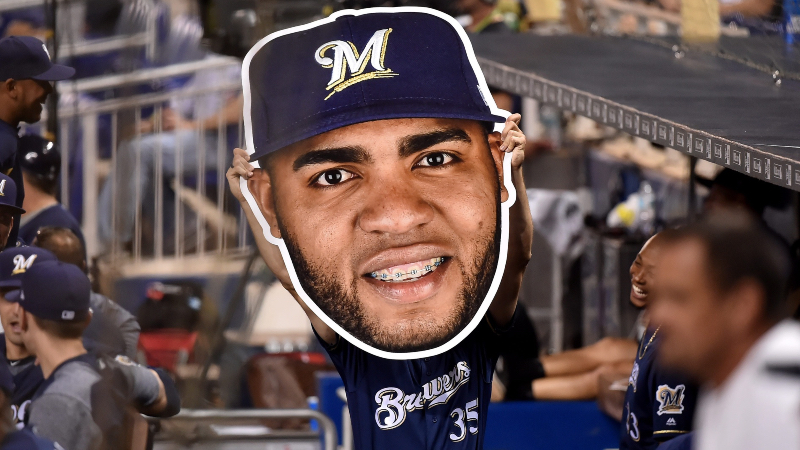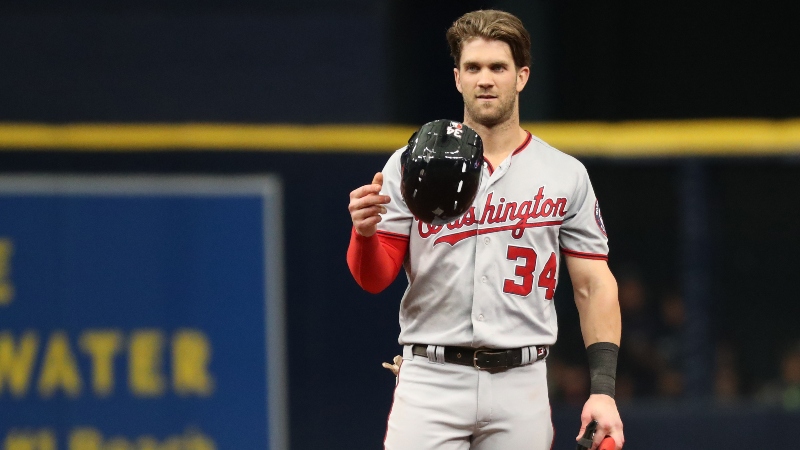The MLB All-Star Break is here, but now is no time for serious sports speculators to take a break. Even though baseball has the longest season of the four major professional sports, players can still experience extended bouts of variance that enable them to run hot. Based on Statcast data, career averages, and season-long trends, here are 10 players who seem likely to regress as fantasy producers in the second half of the season.
Batters
Rockies OF/1B Ian Desmond
First-Half Stats
- .231 AVG, 18 HR, 51 R, 56 RBI, 11 SB
Of all the players in this article, Desmond probably has the most unsustainable numbers. He’s demonstrated excellent power by clubbing 18 home runs, but he has done so by swatting a ridiculous 37.5% of his fly balls over the fence. To put that in perspective: Giancarlo Stanton has a career HR/FB rate of 27.0%. Unless Desmond turned into Babe Ruth in the offseason, his high FB/HR rate is going to regress.
Additionally, Desmond has a league-high ground-ball rate of 62.3%. He’s also produced hard contact on just 36% of his first-half plate appearances, which makes his HR/FB rate seem even more unsustainable. He’ll still benefit from playing half his games at Coors Field, but Desmond has actually averaged a significantly better Plus/Minus on the road (+1.40) than at home (-0.82) during the first half of the season (per our Trends tool).
Angels SS Andrelton Simmons
First-Half Stats
- .314 AVG, 6 HR, 46 R, 41 RBI, 6 SB
A non-factor with the bat for the majority of his career, Simmons has taken some steps forward this season, but he looks like a prime candidate to take a step back in the second half. He owns a career-high .314 batting average on balls in play (BABIP) even though his soft-contact rate ranks 140th out of 163 qualifiers. He’s also benefited from the sixth-highest infield hit rate in the league. Given that he provides very little in terms of power or stolen bases, any regression to his batting average could be disastrous for his fantasy value.
Cubs OF Albert Almora Jr.
First-Half Stats
- .319 AVG, 4 HR, 48 R, 28 RBI, 1 SB
Almora Jr. has been in the top three of the Cubs lineup for the majority of the season, which has helped him to a Plus/Minus of +1.06 on DraftKings. However, he sports the highest BABIP in the entire league at .372, which is extremely unsustainable moving forward. His Statcast profile is also concerning: He owns a soft-contact rate of 24.2% and hard-contact rate of just 29.9% over his first 86 games. Both of those numbers rank in the bottom 25 among qualified batters.
Mets OF Brandon Nimmo
First-Half Stats
- .256 AVG, 13 HR, 48 R, 30 RBI, 7 SB
Nimmo has been a bright spot for the Mets, but his strikeout rate has ballooned to 29.3% while his walk rate has fallen to 11.7% this season, both of which would be new career-worst marks for him if the season were to end today. He’s particularly struggled against left-handed pitchers, owning a 36.0% strikeout rate and a wOBA of just .330 (per our Models), and opposing teams will likely try to exploit his weakness in the second half of the season by matching him up with more lefties out of the bullpen. He owns a BABIP of .342, which is significantly higher than he was commonly projected for at the start of the season.
Yankees OF Giancarlo Stanton
First-Half Stats
- .275 AVG, 23 HR, 58 R, 55 RBI, 2 SB
It looks like Stanton’s MVP season last year was an outlier. He’s having a fantastic campaign, but he’s well off the pace to match his 59 home runs from 2017. His HR/FB rate of 34.3% last season was always going to be tough to duplicate, but it appears that Stanton is making matters worse by trying to take advantage of the short right-field porch at Yankee Stadium. He’s hitting to the opposite field on a higher percentage than he has at any other point in his career, and as a result he’s pulling the ball at a career-low rate of 37.4%. Considering Stanton can pull the ball out of any stadium in the known universe, that seems suboptimal. On top of that, he has an unreal BABIP of .355, which is much higher than his marks of .288, .290 and .294 over the past three seasons.
Pitchers
Cubs Left-Hander Jon Lester
First-Half Stats
- 11 W, 2.45 ERA, 88 K, 1.17 WHIP
Lester has managed to pitch to a 2.45 ERA this season, which has resulted in a solid Plus/Minus of +1.66 and Consistency Rating of 70.6% on DraftKings, but those numbers are a bit of a farce. His strikeout rate has plummeted to 18.6%, which is his lowest mark since 2008. His Fielding Independent Pitching (FIP) of 4.30 is nearly two runs higher than his traditional ERA. He’s survived thanks to an unusually low BABIP of .247, which is especially odd considering he’s induced soft contact at the 12th-lowest rate among starting pitchers.
Indians Right-Hander Corey Kluber
First-Half Stats
- 12 W, 2.76 ERA, 132 K, 0.91 WHIP
Kluber has not been the same pitcher this season, evidenced by his pedestrian Plus/Minus of +0.95 on DraftKings. He’s averaging nearly three fewer strikeouts per nine innings and his worst FIP since 2012. Like Lester, he’s gotten lucky in terms of BABIP: His 2018 mark of .248 is significantly lower than his career average of .294, and any regression in that category could be disastrous for his fantasy value given his large salaries. Kluber is also allowing hard contact on 37.0% of balls put in play this season, which is the worst mark of his career by nearly 10%.
Mets Left-Hander Steven Matz
First-Half Stats
- 4 W, 3.38 ERA, 85 K, 1.25 WHIP
Matz has been a strong pitcher since the start of May, compiling an ERA of just 2.91. However, he’s struggled to miss bats, resulting in a pedestrian K/9 of 7.97. Considering he relies on pitching to contact more than the average starter, his subpar Statcast data is concerning. He’s generating soft contact on just 17.3% of balls in play, ranking 30th out of 80 qualified starters. While that’s not awful, it’s likely his ERA will regress closer to his FIP (4.81) over the second half of the season.
Athletics Left-Hander Sean Manaea
First-Half Stats
- 9 W, 3.42 ERA, 83 K, 0.99 WHIP
Manaea dominated the Red Sox for no hits and 10 strikeouts in his fifth start of the year, but he’s silently struggled since then. In fact, that game represents nearly one-eighth of his strikeouts for the total season even though he’s made 20 starts. His strikeout rate has plummeted to a career-low 16.7%, which is the sixth-lowest mark among qualified starters. His ERA has benefited from an unreal BABIP of .222, but he’s not nearly as good of a pitcher as his traditional numbers suggest.
White Sox Right-Hander Reynaldo Lopez
First-Half Stats
- 4 W, 3.91 ERA, 82 K, 1.33 WHIP
Lopez hasn’t had a ton of fantasy viability in the first half, but he could become a pitcher to stack against in the second half. Relative to his traditional ERA, his xFIP of 5.46 is much higher. He’s been able to keep the ball in the ballpark so far, but if a few more balls leave the yard during the second half of the season his numbers could plummet.
Pictured Above: Ian Desmond
Photo Credit: Isaiah J. Downing-USA Today Sports







